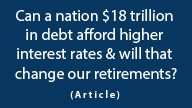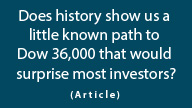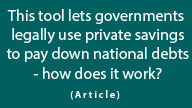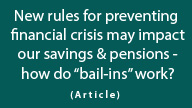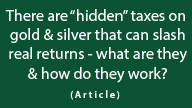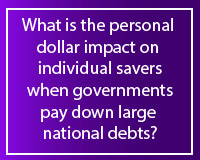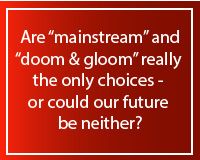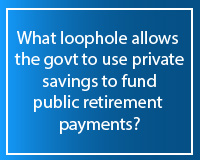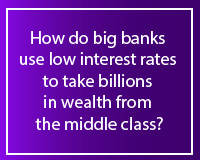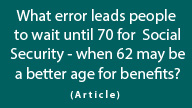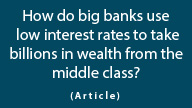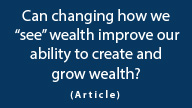Cheating Investors As Official Government Policy
By Daniel R. Amerman, CFA
Overview
The United States government and other nations have increasingly adopted an official economic policy of cheating their own savers, with particular damage inflicted on long-term retirement investors that follow conventional investment practices. This may sound like wild "conspiracy theory" talk, but interestingly enough, the facts involved are not in dispute. Instead they are the very core of official government policy pronouncements, as well as the financial reporting thereof. Going from lofty principles espoused by public servants to the practical matter of deliberately and massively cheating a nation's savers and retirees is not a matter of looking at different facts, but of simply changing the "spin" on well established and accepted facts.
The alternative "spin" that we will apply in this article is one of informed common sense from a free-market perspective. This intuitive, free-market "spin" is radical stuff compared to conventional financial and economic analysis, but I think you will find it easy to follow.
Step outside the herd, apply a little common sense, and it is child's play to convincingly demonstrate that it is official Federal Reserve and Treasury policy to cheat investors in US treasury bonds, notes and bills, as well as in all related categories, such as savings accounts, interest-bearing checking accounts, money market funds, bank certificates of deposit, as well as corporate and municipal debt.
Free Markets Versus Manipulated Markets
Modern portfolio theory is based upon two core assumptions: that investors are rational and that prices are determined by the market. If you remove either one of those assumptions, then the whole edifice of modern financial theory essentially shatters and collapses.
For financial theory to work, investment prices and yields need to be determined by rational buyers and rational sellers finding a place where they can agree upon a price on a particular day or at a particular minute. Without that free market price to provide discipline - the foundations fall apart.
If you don't have a free market price, but you instead have a price determined by a force outside of the market, then you have a manipulated price. If the manipulation is to force prices too low, then the seller is cheated, and if the manipulation is to force prices too high, then the buyer is cheated. If there is any kind of manipulation, then by definition someone is being cheated when compared to a free market.
The state of many of the investment markets in the United States in 2011 is that nobody is getting a free market price for just about anything. This is crucially important, because no matter how purportedly laudable the public policy interest goal is (as explained in the media), every time there is an intervention to manipulate prices, then somebody is being cheated to pay for it. When government policy deliberately forces artificial prices upon a market because politicians don't want the market price to prevail, then in every transaction in that market one side is either paying too much, or one side is getting paid too little. This is not the conventional "spin", but it is an intellectually valid perspective that has powerful real world consequences for the current and future lifestyles of many tens of millions of responsible savers and investors. This issue also includes stocks, but this article will focus on instruments that pay interest to investors.
Manipulated Interest Rates
Let's consider the traditional role of the Federal Reserve in trying to determine the federal funds rate, which is how the Fed tries to influence or control all short-term interest rates in the United States. This is not exactly a new or disputed fact, indeed for decades one of the most reliable parts of the business reporting cycle is the media anticipating and then analyzing the results of every committee meeting, trying to see where the Fed is moving interest rates.
This is where the common sense free market "spin" part comes in. In other words, the most heavily covered aspect of Federal Reserve activity on a traditional basis is trying to guess how the Federal Reserve is going to manipulate interest rates. Are they going to attempt to override the market to move interest rates up or override market forces to move them down? After all, that is the whole idea. If the Federal Reserve accepted the judgment of the market for interest rate levels, there would be no need to intervene.
The overwhelming emphasis of the historically unprecedented Federal Reserve interventions in recent years has been to keep interest rates as low as they can possibly be. Indeed, much lower than they would be in a rational market. What this means is the Federal Reserve has been manipulating short-term interest rates so that purchasers of short-term securities, as well as all savers in general, are being systemically cheated out of the yields they would otherwise get in a free market.
This a fascinating example of how the remarkable becomes the norm almost without comment - when that serves the interests of powerful special interest groups. It has been a very long time since anyone in the US has been rewarded for responsibly saving their money in savings, money market or interest-bearing checking accounts. The paltry interest rates have lagged well behind even the official rate of inflation. For an economically rational person - saving money has been actively discouraged as an incidental by-product of government policy. While periodically "tsk-tsking" those irresponsible average citizens and saying they really should be saving more, what the government has actually been effectively encouraging is the exact opposite - because artificially low interest rates better serve bank and corporate borrowing needs.
In the 20th Century the Federal Reserve intervened in just one corner of the markets, that of short term interest rates, with a primary focus on interbank lending. These interventions historically had a powerful influence (albeit not direct control) on short term interest rates of all kinds, but they had a lesser influence on medium term interest rates, and still less of an influence on long term interest rates. The overall economy and general asset values were also influenced, but the Federal Reserve was only one of numerous influences; it didn't truly control and manipulate the overall markets.
Now let's consider our current situation where food prices are spiking, energy prices are soaring, and the Federal Reserve for the first time since the Civil War is engaged in a massive policy of straight up monetization (i.e. creating money out of thin air to directly fund endless federal deficits). This is surely a combination of circumstances that in a free market would lead to soaring interest rates. Inflation is not merely on the horizon, rather it is all around us when we look at food costs, fuel, heating and health care. The Federal Reserve is basically flicking lit matches at pools of gasoline when it comes to the future value of the dollar with its policy of monetization. Indeed, the (successful) strategy being pursued by the US in waging currency warfare is to threaten to destroy the value of the dollar through monetary creation.
Arguably, free market interest rates should be soaring, as investors seek protection from inflation. Yet when we look at short-term interest rates they are some of the lowest in financial history. Because the free market has nothing to do with what we as savers are being paid, this is an entirely manipulated market.
Indeed the Federal Reserve has been radically increasing market interventions to try to manipulate interest rates in areas where traditionally it has not been able to do so because of previously (but no longer) limited Federal Reserve powers.
One unprecedented intervention was that for over a year, between 2009 and 2010, the Federal Reserve created an almost entirely artificial mortgage market to essentially fund every mortgage being originated in the US, and keep mortgage rates well below what market interest rates would have been. This manipulation was so overt and massive that not enough buyers could be found, so the Fed had to directly create over $1 trillion in new money to fund the purchase of effectively all new conforming mortgage originations (on a net basis) at far below market yields, as covered in my article "Creating A Trillion From Thin Air".
http://danielamerman.com/articles/Trillions.htm
While the powerful price and yield distortions drove many buyers away, there was still a continuous and functioning market, meaning every day private buyers were grossly overpaying for mortgage securities. That is, on a net basis, Federal Reserve monetary creation put enough new money into the market to effectively fund the purchase of all newly created mortgage securities, but it did not comprise the entire trading volume of the market; private parties bought and sold from each other every trading day at the manipulated prices. Individuals who knew little about the unprecedented Federal Reserve actions, but who were following the traditional strategy of the last several decades of boosting yields above Treasury bonds via buying agency mortgage securities, or who bought into funds following that strategy, were being quite blatantly cheated and were paying much more than they should have had to, because of the artificial market.
The stated purpose of QE2 (the second round of so-called "quantitative easing", aka running the printing presses) is for the Federal Reserve to directly manipulate medium and long-term treasury bond rates with the idea of encouraging corporate borrowing. I wrote about this in detail when QE2 was first announced, but despite the Fed openly stating exactly what it planned to do, few financial writers seem to understand exactly what the Fed is in fact doing.
As announced by the Fed, and described in my article "Radical Difference Between Monetization 1 and QE2" linked below, the Federal Reserve is not actually directly funding the Treasury. Even though the Federal Reserve is directly creating money out of thin air at a rate approximately equal to the US budget deficit, and using the money to buy Treasury Bonds, the Fed is buying them in the market rather than directly - and they aren't the same securities. Part of the reason is that it is illegal for the Fed to directly fund the Treasury (though a simple act of Congress could cure that at any time if need be). The bigger reason is that the Federal Reserve is attempting to manipulate all interest rates in the US through controlling short, medium and long term Treasury Bond rates, so it is using the money not to directly fund, but to intervene wherever it thinks the market is most in need of intervention. By controlling the secondary rather than the primary market (my apologies for the jargon), the Fed takes control of all interest rates.
http://danielamerman.com/articles/Monetize1.htm
As discussed in the article above, the Federal Reserve has an unlimited supply of dollars, and is using not just the massive creation of money, but the knowledge of other buyers and sellers that the Fed is in charge, to effectively control the markets in US Treasury securities. If a financial firm were to risk its capital and take a huge position speculating that interest rates will rise to an impermissible degree, the Fed has unmatched resources to force interest rates down, force a major trading loss, and quash the uncooperative firm in question. On the other hand, so long as the investment banks follow the lead of the Fed (and they are), then they make "free money" and trading profits without end by following the script fed to them by their cronies at the Fed and the Treasury, profiting from the easiest counterparty in the world to trade against, that being the government.
The ripple effects of this overtly manipulated and rigged insider's game reach into our day to day lives all across the nation. That is because Treasury yields are the base from which virtually all other interest rates are determined. Whether we are talking about certificates of deposit, corporate bonds, municipal bonds, junk bonds, fixed rate annuities, credit cards, prime-based lending, or home equity lines - the base is the Treasury yield for that maturity, and then a spread is added to it. Control the Treasury yields - and one controls almost everything (other than the spread).
When interest rates in general are manipulated, what does that mean for savers and investors?
When you put your savings into a money market fund, and the policy of the US government is to force interest rates to unnaturally low levels - you are being cheated out of the yield you should be receiving.
When you buy a corporate bond or corporate bond fund - you are being cheated by overt government market interventions that have the explicitly stated purpose of lowering corporate borrowing costs. This is where that "spin" comes back in. How does a government lower borrowing costs for multinational corporations, enabling them to take the proceeds and invest them overseas? (Taking the money and investing it out of country seems to be the most common behavior so far.)
The government does so by manipulating the market so that investors receive much lower interest payments than they would receive in a free market. In other words, it directly creates benefits for corporations and banks by cheating ordinary investors out of the income they would receive if free market forces governed. Boil it down to another level, and this is a fairly straight up redistribution of wealth from average citizens to corporate interests.
Wherever the investor goes, whatever interest-bearing investment they look to - there is no escaping the cheating, because there is no escaping the unprecedented direct government control over interest rates. Even as inflation rises (in the real world rather than the also manipulated world of government statistics), there is nowhere for the fixed-income investor to find compensation for current inflation or inflationary pressures. Which, in a free market, would likely be the dominant market forces at this point.
Adding to the irony - and the tragic dilemma for us all - is that the market manipulation is being paid for by the Federal Reserve creating brand new money out of the nothingness, so to speak, at the rate of about $1,000 per US household per month. This is creating perhaps the greatest inflationary pressures of our lifetime. In other words, government policy is to risk the value of all of our savings in the future, in order to fund a program of cheating us out of market interest rates today. And this thereby ensures that none of us are compensated for the inflationary risks, or are able to prepare for the destruction of the value of our money by way of conventional methods.
It's all in the "spin", and this paradigm is not that difficult to see when a common sense and free-market perspective is introduced.
Arbitraging Market Manipulations
At the beginning of this article, I promised to take some well-accepted facts, put a free market "spin" on them, and convincingly demonstrate that tens of millions of investors were being cheated out of their investment returns by their own government. Are you convinced? Do you accept the systemic cheating?
If you do, then you have the potential to do something about it. Maybe even do something extraordinary. Remember, the whole idea behind manipulating markets is that one set of either buyers or sellers gets cheated, and the other gets an incredibly good deal which they should not otherwise be able to get.
Now the problem for the average investor is that what we are told to do is to be the sucker in each one of these situations. We want to be the ones who put as much as possible of our savings into money market accounts, or into buying the certificates of deposit. Where things grow interesting and challenging - but the rewards can potentially become extraordinary - is when we figure out how to change our financial profile so that we are the beneficiaries of market manipulations rather than being the victim of these manipulations.
It isn't easy, and there are several hurdles. The first difficulty is the one that most people will never get past, and that is to truly reject the overwhelming Voice Of Authority when it comes to the conventional financial "wisdom". That overwhelming voice that resounds from the universities, from the investment houses, from millions of financial representatives of one kind or another, from the newspapers, magazines and financial websites, and from our friends and relatives. What was covered in this article could be called no more than common sense in some ways, but it is radical common sense, almost on a different continent from the overwhelming force and authority of the conventional perspective.
This overwhelming Voice of Authority is intellectually bankrupt for the reasons discussed in this and other articles. It is a voice that systematically cheats tens of millions of responsible savers and investors every year in numerous ways. It is a voice that we must learn to reject if we are not to be cheated.
For most of us, we are who we are, and are in the position in life that we are in, and there is only so much of our financial profile that can be changed. I've worked on these issues for a long time, and the way I see it - that doesn't mean that we have to accept victim status. Instead, it heightens the importance of identifying what we can change, what is within our control. We can then go ahead and make those changes, because achieving highly positive results in the areas we can control is arguably the only way of protecting ourselves from damage in those areas that we can't control.
To protect ourselves, we must take what we can control, and position it so that market manipulations redistribute wealth to us rather than away from us. This is the core of what must be done. Yet, there is the major difficulty that most of the manipulation profits will go to the government, major banks and corporations, and other powerful insiders. We can and should scream in moral outrage, but that's not likely to change the way things are. Most of the redistributions of wealth are simply inaccessible to the average person.
That said, there are trillions of dollars in manipulations happening on a national and even global scale. So much is changing so fast that there are also numerous "open doors" in unexpected places. There are opportunities to reposition ourselves so that wealth is redistributed to us instead of taken from us. These doors are still open now, but many are starting to close and our time to access them is limited, at least in the US.
Now, if we identify the part of our financial profile that we can change, and we find an open door or doors of opportunity to benefit from manipulated markets, and we bring those two together - we can achieve something remarkable: personal transformation. A fundamental repositioning that gives us the ability to reject victim status, if only we will take action.
I believe that one of the largest redistributions of wealth in history is coming upon us. It will devastate tens of millions. Because it is a redistribution, it will also be perhaps the greatest wealth creation opportunity of our lifetime. The difference between devastation and opportunity, between having wealth redistributed from us and having wealth redistributed to us, will be about taking personal responsibility, and taking personal action. Which means having the knowledge to spot the opportunities and take the actions.
 What you have just read is an "eye-opener" about one aspect of the often hidden redistributions of wealth that go on all around us, every day.
What you have just read is an "eye-opener" about one aspect of the often hidden redistributions of wealth that go on all around us, every day.
 A personal retirement "eye-opener" linked here shows how the government's actions to reduce interest payments on the national debt can reduce retirement investment wealth accumulation by 95% over thirty years, and how the government is reducing standards of living for those already retired by almost 50%.
A personal retirement "eye-opener" linked here shows how the government's actions to reduce interest payments on the national debt can reduce retirement investment wealth accumulation by 95% over thirty years, and how the government is reducing standards of living for those already retired by almost 50%.
 An "eye-opener" tutorial of a quite different kind is linked here, and it shows how governments use inflation and the tax code to take wealth from unknowing precious metals investors, so that the higher inflation goes, and the higher precious metals prices climb - the more of the investor's net worth ends up with the government.
An "eye-opener" tutorial of a quite different kind is linked here, and it shows how governments use inflation and the tax code to take wealth from unknowing precious metals investors, so that the higher inflation goes, and the higher precious metals prices climb - the more of the investor's net worth ends up with the government.
 Another "eye-opener" tutorial is linked here, and it shows how governments can use the 1-2 combination of their control over both interest rates and inflation to take wealth from unsuspecting private savers in order to pay down massive public debts.
Another "eye-opener" tutorial is linked here, and it shows how governments can use the 1-2 combination of their control over both interest rates and inflation to take wealth from unsuspecting private savers in order to pay down massive public debts.







If you find these "eye-openers" to be interesting and useful, there is an entire free book of them available here, including many that are only in the book. The advantage to the book is that the tutorials can build on each other, so that in combination we can find ways of defending ourselves, and even learn how to position ourselves to benefit from the hidden redistributions of wealth.


